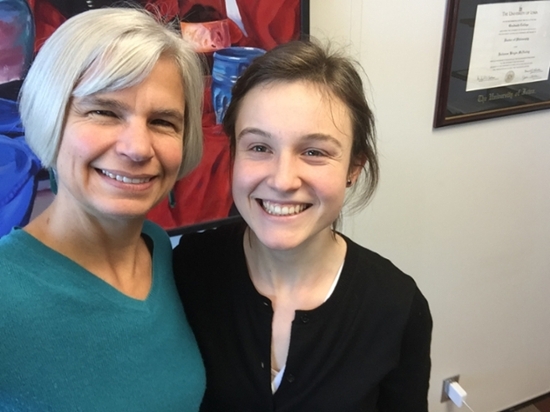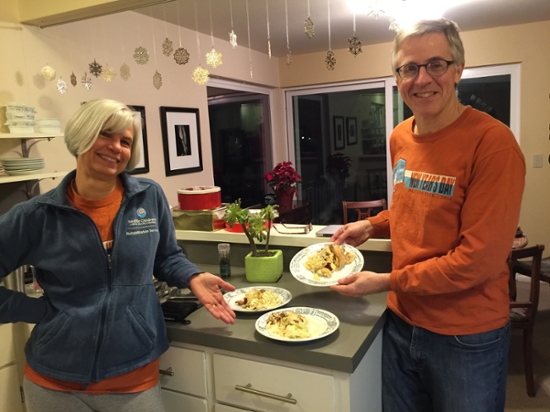North Seattle College, Haley Tilt, Winter Shadow 2016

Julie and Haley at Julie's office.
Two days ago I arrived at Julie Kirgis’s home overlooking the Puget Sound. Julie is the Dean of Arts and Humanities up at North Seattle College, but she also has a strong background in sociology research. Since I hope to go into education administration or research (I don’t know which yet), hanging out with Julie for a few days seemed like an awesome opportunity.
That first evening, Julie and I made a quiche together in a pie pan whose generous depth resulted in a soupy final product. Tom, Julie’s husband (and a Reedie), recommended that we flip the quiche upside-down in a saucepan and drain off some fluid. Since that made the crust soggy, I suggested we put it back in the oven. After three hours the quiche looked like we’d run it through a centrifuge, so much had it separated into its component parts. 
Coming away from it all, I want to emulate the way Julie goes above and beyond to inspire a sense of community among her faculty and a sense of trust between them and herself. Of all the administrators “on the dark side” (according to the faculty), Julie’s faculty really seem to believe that she has their best interests at heart—because she does, and she lets them know it. I got to see Julie lead large meetings, meet with all of the North Seattle deans in the “cone of silence,” and support her faculty one-on-one. On one occasion, a faculty member wanted to come in just to vent that she was planning to overload her own class by three students. She wanted to do it because she knows that these students really need the class, but for her this meant extra grading and no extra pay. Julie was the listening ear who acknowledged that no, that’s not fair. But at the same time, as an administrator, Julie balances the budget and makes sure that her division isn’t running classes they can’t afford (classes without enough butts in seats). That means she’s also responsible for cutting classes and trying to get classes as full as possible. She’s often responsible for making unpleasant decisions that mean fewer jobs for teachers and cancelled classes for students. The fact that her faculty still trusts her and comes to her with their frustrations is remarkable.
Since Julie was also able to arrange for me to meet a bunch of her colleagues, I never had any illusion that anyone here at North Seattle was on “the dark side.” To the contrary, like Julie, everyone is doing the best they can with very limited resources to serve the students they care so much about.
One of the questions I’ve asked almost everyone at North Seattle is how they see research inform their practice. This is an important question for my future. Are the studies I someday want to carry out as a researcher likely to have any practical effect in academic institutions? Does promising research influence best practices at community colleges, or does it get washed up in the flotsam of academic journals? If someone is actually reading my research, who is it? Where do they fit into their institution, and what kind of changes do they actually have the time, interest, and authority to implement?
The answers I got were heartening to a future researcher. All of those I spoke to—the Associate Dean of Student Services, the Associate Dean and the Instructional Designer of E-Learning, the Dean of Basic and Transitional Studies—use research that has been produced internally or externally to guide how they train their staff and faculty, to determine which initiatives to promote, and to assess the effectiveness of initiatives that have been put into action. North’s Institutional Researcher, Stephanie Dykes, plays a huge role in making sure that decision-making includes a significant research component. Julie is especially active in reading journals on Higher Ed and disseminating the most useful research to her faculty. What was less encouraging was that most of the people using research produced externally to North have or are working toward PhDs in education—in other words, they occupy a special position between the academy and their role as practitioners at North Seattle, and it is from this special position that they view Higher Ed research as both accessible and essential to their role as effective administrators.
Academic research initiatives that go directly into schools are usually localized. Stanford, for example, works primarily in schools around the bay area. K-12 districts and community colleges that aren’t in the immediate vicinity of an institution doing education research miss out on this opportunity. Another kind of academic research seeks to benefit a larger national or international community. This kind of research gets published and may be read by practitioners, or may fall to the wayside, since it’s often published in rather snobbish looking journals and otherwise little promoted (online research digests may be the exception). In the worst case scenario, administrators at schools with tight budgets may not even be able to access research if it’s published in databases and journals with costly subscriptions.
One point on which I heard consensus was that regional conferences and dissemination of research through the state board is extremely helpful, and does help administrators make decisions. Policy-making at the level of the state board is in turn influenced by external research. However, since so many decisions are made on a district-by-district or college-by-college level, I do wonder whether state board policy making is the most effective channel by which research can reach practitioners. This is a question I hope to keep with me if I move on to working in research. What makes research accessible, and what’s the best way to promote findings to the people it can benefit most? How can large research institutions do more to reach little colleges outside their direct proximity? I—like everyone I’ve met here at North Seattle—am interested in education because I’m committed to promoting social equity and believe education is the best way to do that. Moving forward in my career, I need to always remember that progressive solutions only make a difference if they are implemented. Fortunately, my time at North Seattle gave me confidence that everyone is doing their best to make sure that the right questions do get asked, that the most promising solutions do get proposed, and that the best job be done for every single student that comes to North Seattle.
Tags: research, education, community college, administration, winter shadow, northwest
